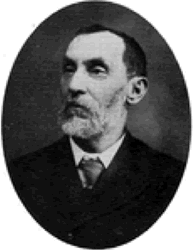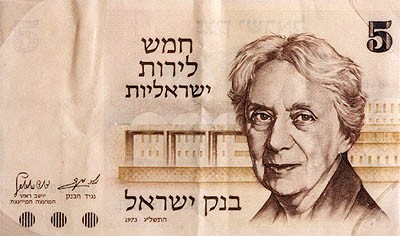Scholar, author, Zionist
1. Born in Lithuania in October 1843, he was given a traditional Talmudic education, and in 1865 started a yeshivah in Vilna.
2. Beginning In 1868, he wrote articles in Hebrew that called for reform in the practice of Judaism that would bring a closer connection between religion and life. He proposed changes in line with the changing conditions of modern life – suspension, for example, of the prohibition against legumes during Passover in the wake of a famine in Lithuania. He argued that the oral law was a human creation that had developed historically and contained internal contradictions. His language was sober, clear and well-reasoned – and it raised a storm of controversy in his orthodox surroundings. In 1869, having been denounced as a freethinker, he moved to Odessa.
3. Now the darling of the movement for reform, he nevertheless felt himself alone in Odessa, where he despaired of the possibility of a compromise between Jewish law and modern life. He read widely among radical writers, including Mapu [see my blog post of February 20]. Compelled by historical explanations for biblical composition, he lost his faith in the divine source of the Torah.
 4. He edited a Yiddish newspaper in which were published a series of articles entitled “Jewish Life Questions.” He wrote, “All human beings live on the earth, but the Jews live in heaven. Even modern Jewish literature has not yet managed to come down to earth, and most of it hovers in the air.”
4. He edited a Yiddish newspaper in which were published a series of articles entitled “Jewish Life Questions.” He wrote, “All human beings live on the earth, but the Jews live in heaven. Even modern Jewish literature has not yet managed to come down to earth, and most of it hovers in the air.”
5. By 1873, at the age of 30, he was publishing an autobiography, The Sins of Youth, a narrative that reflected the spiritual and social problems of those who no longer fit into traditional society, but who found only frustration in the culture of the city.
6. In 1878, his parody of the Mishnah was published serially in a radical Hebrew journal. Using the form of the sacred text, he promulgated social, political and economic ideas of social reform. This secularization of holy language had a major influence on his peers.
7. The widespread pogroms of 1880-81 led Lilienblum to question his faith in progress, in the rule of human reason, and in the possibility of integration of Jews into European society. He later said that the close proximity of the pogroms led him to “know and feel the life of my nation during the exile.”
8. He now believed that the higher Jews rose on the social and economic ladder in their various countries, the more precarious their position would be. Security for Jews could only come in a territory where they could form a majority. Toward this end, in 1883 he founded the Odessa committee of Hovevei Zion and served as its secretary until his death, working alongside Leon Pinsker to organize and assist agricultural settlement while continuing his literary activities. Settlement of the land had become his priority, and he devoted much of his time to it; reform of Judaism took second place.
9. Lilienblum’s writings included poetry, literary criticism, a history of the Hovevei Zion movement, a psychological profile of Moses, two autobiographies (the second was published 1899), and a theatrical piece. Zerubavel, his Yiddish play, was the first modern drama to be produced on the stage in Eretz Yisrael, performed by students in Jerusalem in a Hebrew translation.
10. He died in 1910, having become one of the most important writers produced by the movement for a Jewish national culture. With his deep Jewish learning and his knowledge of European modernism, his writing – both literary and journalistic – argued persuasively for a new Jewish nationalism based on a new Jewish identity.
Kfar Mala is named for Lilienblum; an agricultural moshav in the Sharon region north of Petach Tikvah, it is also the birthplace of Ariel Sharon.
In Tel Aviv, Lilienblum Street runs between Neve Tzedek and Nahalat Binyamin and is known for its restaurants. The first cinema in Israel was established at 2 Lilienblum.





